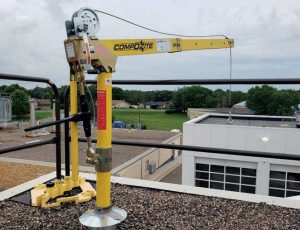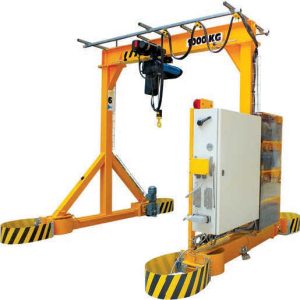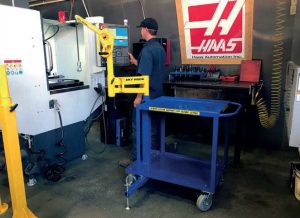Portable cranes are generally hand powered and can be lifted or moved by one person. Julian Champkin looks at these light but useful lifters.
- A rooftop mounting for a CompOZite davit from Oz Lifting Products.
- Granada Material Handling supply Comege motorised gantry cranes.
- The Sky Hook range of portable cranes is manufactured by Syclone Attco..
Firstly, to define portable cranes: they are carried, or sometimes pushed, and generally by hand, though sometimes a forklift or an overhead hoist can be used. When they are carried by hand it is generally by one person. A common practice is to have sockets set in various places around a factory floor, with a single crane that is moved between them as and when it is required.
This of course means they have to be lightweight. That in turn means that their structures tend to be simple: many are davit designs—a vertical mast or kingpost with an arm—with some gantries used as well. And being lightweight they are used for lighter tasks, and are generally operated by hand. There are exceptions to all the above statements, and we shall come to them, but we can start off with cranes that fit the criteria fairly exactly.
Typically, they are used in smaller workshops and factories that have an occasional need to lift something slightly too heavy or awkward for one man to lift easily. When the cranes are not needed they can be carried out of the way to a storeroom, to be brought out the next time they are required. Again, there are exceptions. “That is accurate, but it is not the whole story,” says Dusty White, technical sales manager of Idaho-based Syclone Attco, makers of the Skyhook range of portable cranes. “We are useful to those many small factories and concerns, but not only to them. We regularly supply to the semi-conductor industry, to aerospace, to automotive and to others.
“Every industry has components that it has to move around, and they are of that weight and awkwardness that makes a guy say to a colleague ‘Hey, can you give me a hand moving this?’. That is where people get injured; and reducing that is our business.”
It is, he says, even more important just now, given the crisis in public health. “Two people lifting something by hand together—that is where they get too close for social distancing recommendations.” Reducing a two-man lifting task to a one-man job can be essential to carrying out safely the job in hand, and to keeping production going.
“We have actually had a massive response from customers trying to adhere to social distancing requirements. Twoman lifts are a thing of the past now,” he says. “A portable crane gives the solution that people need for getting the job done while still staying safe. And I am proud to say that some of the jobs we are helping to get done are in the factories making the sanitisers, the ventilator machines and the protective clothing that are helping to fight the virus.”
Reid Lifting, based in Monmouthshire in Wales, make gantries and davits. The company has a T Davit and a Porta Davit range, as well as gantries, and has recently launched a dedicated US operation to expand its business. Their products use aluminium to keep weights low.
“Lightness is a key design consideration,” says MD Simon Luke, “as is ease of transporting it, but so is speed of erecting it. Five minutes assembly time is easily achievable on all but our larger gantries. All our smaller cranes, up to 2t capacity with shorter beams, can certainly be set up and moved by one person, without tools.
Because of the unique way our product is assembled, the person setting up the crane never has to bear the full weight of any of the component parts. We have online assembly videos to show how this can be done; it is true even of our ingenious Porta Gantry Rapide, which is a unique award winning patented design. It is a one-piece folding gantry, with one tonne capacity, that can be easily moved around a work site and used for many different tasks not limited to lifting goods. It can lift personnel as well and act as an anchor point for fall protection. It has a beam length of up to 4m.
“Our standard Porta Gantry is larger, a three-piece unit, with a range of height options and beam lengths and capacities of up to 5t.”
It may come as a surprise that light portable cranes can be used for personnel lifting, but in fact their capacities can be well within required safety limits. “Of course all personnel lifting operations should be carefully planned and include a risk assessment, a method statement and a rescue plan. And we would always recommend more than one person, and all involved should be trained and competent.
Portable cranes are generally hand powered and can be lifted or moved by one person



没有评论:
发表评论